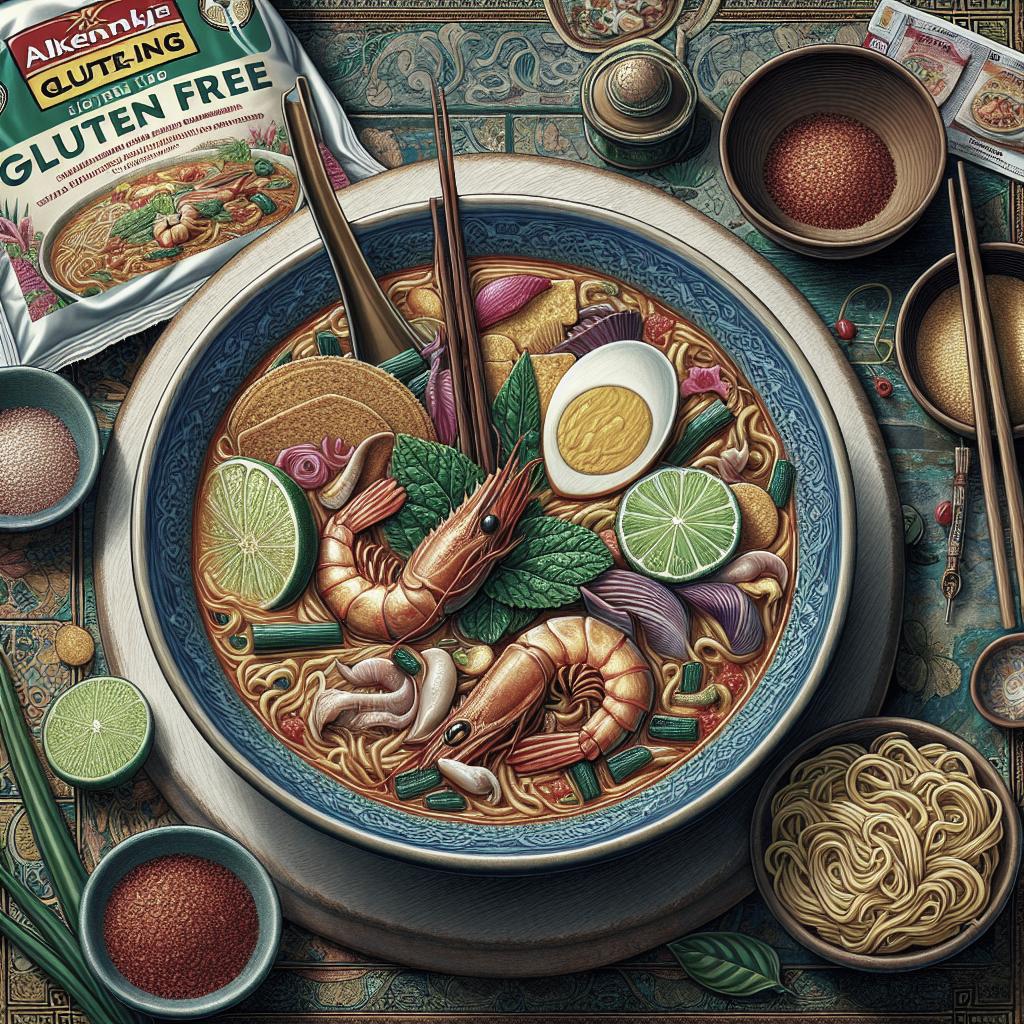Is Laksa Gluten Free?
Laksa is a beloved Southeast Asian dish that tantalizes taste buds with its spicy coconut broth and delightful combinations of noodles, meats, and seafood. In this blog post, we explore the classic characteristics of laksa and delve into its gluten-free possibilities. We’ll introduce a Chicken & Prawn Thai Laksa recipe suitable for paleo and keto diets, discuss the essential ingredients for an authentic laksa experience, and offer tips for creating the perfect bowl at home. We also provide other healthy Thai recipes for those looking to expand their culinary repertoire. Whether you’re a seasoned cook or a curious foodie, join us in discovering the nuanced world of laksa and finding ways to enjoy it while adhering to gluten-free dietary needs.
What Is Laksa?
Laksa is a rich and flavorful noodle soup that finds its origins in the Peranakan culture, which is a fusion of Chinese and Malay culinary traditions. This vibrant dish is renowned across Malaysia, Singapore, and Indonesia, each region boasting its own unique take on the classic recipe. Typically, laksa consists of a coconut milk-based soup with spicy undertones, poured over soft rice noodles, and topped with various proteins such as chicken, shrimp, or tofu. Laden with bold flavors, laksa stands out as a quintessential representation of Southeast Asian cuisine.
The popularity of laksa has grown internationally as well, with many variations adapting to local tastes and dietary preferences. One common question that arises is whether laksa is gluten-free. Traditional laksa includes rice noodles, which are naturally gluten-free; however, it’s crucial to consider the other components that may contain gluten, such as soy sauce or certain pastes used in the broth. With a growing focus on gluten-free diets, home cooks and chefs alike are finding creative ways to adapt laksa and retain its authentic taste while catering to gluten-sensitive individuals.
Chicken & Prawn Thai Laksa (Paleo, Keto)
Ingredients
Creating a gluten-free Chicken & Prawn Thai Laksa involves selecting the right ingredients that honor tradition while hedging contemporary dietary standards. For this dish, you’ll need chicken breast, deveined prawns, and coconut milk. Additional ingredients include garlic, ginger, and Thai red curry paste – ensure it’s gluten-free by checking the label. You’ll also need lime, fish sauce, and chicken broth. Paleo or keto variations might substitute traditional rice noodles with spiralized zucchini or shirataki noodles, catering to both dietary preferences and inviting texture.
Fresh cilantro, bean sprouts, and sliced red chili add vibrant garnishes, enhancing both the visual appeal and the flavor spectrum of the laksa. It’s important to have all these ingredients ready before you start cooking to ensure a seamless and enjoyable culinary preparation process.
Instructions
Begin by heating a mixture of coconut oil in a large pot over medium heat. Sauté minced garlic and ginger until they are fragrant, which should take about 2-3 minutes. Stir in the Thai red curry paste, allowing it to cook and release its aroma. Gradually add the chicken broth and coconut milk, stirring constantly to combine the flavors at every stage. Bring the mixture to a simmer, then add sliced chicken breast and prawns. Cook until the chicken is fully cooked and the prawns turn pink and tender.
Next, incorporate fish sauce and lime juice to taste, adjusting as necessary to achieve your preferred balance of sour and salty within the soup. If you’re opting for zucchini noodles or another non-traditional noodle, add them in at this stage, allowing them to soften gently in the broth. To serve, garnish with cilantro, sliced red chili, and bean sprouts. This Thai laksa variant promises warmth and richness with every bite, staying true to its comforting roots while adapting to healthy, contemporary standards.
Nutrition
This adaptation of Chicken & Prawn Thai Laksa is crafted to satisfy cravings without causing dietary disruptions. High in protein from both chicken and prawns, it’s an ideal meal for those pursuing low-carb, high-protein goals intrinsic to keto and paleo diets. The absence of traditional noodles further minimizes the carbohydrate count, making it a beloved choice for gluten-sensitive or celiac individuals. Coconut milk infuses healthy fats while offering a creamy consistency to the soup.
Beyond its macronutrient breakdown, this dish is also rich in vitamins and minerals, thanks to the inclusion of fresh herbs and vegetables. The antioxidant properties of cilantro and chili peppers contribute to an overall wholesome and hearty meal that nourishes both the body and soul.
Tips For Making Thai Laksa At Home
Achieving an authentic Thai laksa at home requires attention to the quality of ingredients and the careful balancing of flavors. As a practical starting point, consider using fresh ingredients wherever possible – fresh ginger, garlic, and lemongrass can immensely amplify the flavor profile. Ensuring your curry paste and fish sauce are gluten-free is vital to meet dietary requirements without sacrificing taste.
Aromatic harmony is achieved by allowing your spices to bloom during the initial cooking stages. Take time to sauté your aromatics and paste thoroughly, as this essential step unlocks their full flavor potential. Additionally, don’t shy away from taste-testing throughout the cooking process, gradually refining the soup’s brightness with lime juice or enriching the broth’s depth with additional fish sauce.
Other Laksa Ingredients You Need
While coconut milk and curry paste form the cornerstone of any laksa dish, other ingredients can significantly elevate the dish’s authenticity and complexity. Tofu or tempeh provides a protein alternative if you prefer meatless variations, while kaffir lime leaves or galangal can enhance the dish’s citrusy notes. Choosing the right type of noodles is also critical – rice noodles are gluten-free and traditional, though alternatives like konjac noodles offer a low-calorie substitute.
Incorporating fresh vegetables such as pak choy or bell peppers not only diversifies the texture but also adds a nutritious boost. Consider garnishing with additional toppings such as a hard-boiled egg or a splash of coconut cream for added luxury. The realm of laksa ingredients is broad, allowing you to tailor the dish to your dietary needs or specific taste relaxation.
More Healthy Thai Recipes:
Save This Recipe To Pinterest
Once you’ve conquered the art of creating Thai Laksa, why not explore other healthy Thai recipes? Delve into the bright tastes of Tom Yum soup or crisp, refreshing som tum salads, which perfectly blend flavors of sweet, spicy, and sour to create an endless feast. These dishes offer the same exotic charm as laksa yet can be seamlessly integrated into everyday meal plans with ease of preparation.
Encourage family and friends to embark on this culinary journey by saving your favorite recipes on Pinterest. With a dynamic arsenal of healthy Thai recipes, your kitchen can become a haven of balanced, flavorful dishes worthy of sharing with loved ones.
Comment or Rate This Recipe
Leave a Reply Cancel reply
Your feedback helps others discover the rewarding experience of cooking Thai laksa at home. Share your thoughts, adaptations, or even pairings you might recommend to those just beginning their culinary journey with this phenomenal dish. If you make modifications based on dietary needs or ingredient availability, kindly share these insights with fellow food enthusiasts.
Satisfying, aromatic, and adaptable, Chicken & Prawn Thai Laksa awaits your personal touch and constructive feedback. Whether you rate the recipe, comment on how it fits into your lifestyle, or offer tips for those with dietary restrictions, your voice is a valuable addition to this vibrant community of culinary explorers.
Comments
Join our conversation and discover shared experiences as fellow readers share their stories about navigating the extensive palate of Thai cuisine. Drop a comment about how Thai laksa harmonizes with your tastes or offer insights for adapting it further while keeping within nutritional preferences. We celebrate the diverse adaptations that echo the core theme of laksa’s inclusive culinary legacy.
| Topic | Details |
|---|---|
| What Is Laksa? | Originating from Peranakan cuisine, laksa is a rich noodle soup popular in Southeast Asia, known for its spicy coconut base and versatility. |
| Recipe | A gluten-free Chicken & Prawn Thai Laksa modified for paleo and keto diets with a detailed ingredient list and step-by-step instructions. |
| Key Tips | Focus on fresh, quality ingredients, balance flavors, and ensure all components, like curry paste and sauces, are gluten-free. |
| Other Ingredients | Explore protein options like tofu and varied fresh vegetables while choosing the right noodle type for authenticity and dietary needs. |
| Additional Recipes | Suggestions for exploring more healthy Thai recipes, emphasizing accessible yet authentic culinary adventures. |


